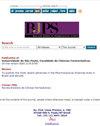Gastroprotective potential and mechanisms of action of Hedera nepalensis
IF 0.9
4区 医学
Q4 PHARMACOLOGY & PHARMACY
引用次数: 1
Abstract
traditionally used to treat stomach problems. The current study investigated the gastroprotective potential and the mechanism of action of H. nepalensis in diclofenac-and ethanol-induced ulcer models. Anti-oxidant and lipid peroxidation inhibitory prospects of H. nepalensis were checked out by free radical scavenging assay and UV spectrophotometer respectively. Effect of H. nepalensis on the pH, gastric total acidity of gastric juice and protective effects of H. nepalensis against ulcer models have been examined. Histopathological studies have been carried out. The aqueous methanol extract of H. nepalensis (100 µg/mL) showed anti-oxidant (83.55%) and lipid peroxidation inhibitory (70.88%) potential at 1000 µg/mL; the extract had no buffer potential. The extract (400 mg/kg) significantly (81.12% and 63.46%) showed gastroprotective effect in diclofenac and ethanol-induced rat ulcer models respectively. Histopathological studies confirmed the biochemical findings. FTIR analysis showed the presence of carboxylic acid, alkanes, conjugated alkanes, aldehydes and alkyl-aryl ethers. Gallic acid, M-coumaric acid and quercetin were found by HPLC analysis. H. nepalensis exhibited significant protection against diclofenac and ethanol induced gastric damage by anti-oxidant and lipid peroxidation suppression effects suggesting potential broad utility in treatment of diseases characterized with gastric damage.尼泊尔黑德拉的胃保护潜能及其作用机制
传统上用于治疗胃病。本研究探讨了尼泊尔草在双氯芬酸和乙醇诱导的溃疡模型中的胃保护潜能和作用机制。采用自由基清除法和紫外分光光度法对尼泊尔石竹进行了抗氧化和抑制脂质过氧化的研究。研究了尼泊尔香薷对胃液pH值、胃液总酸度的影响以及尼泊尔香薷对溃疡模型的保护作用。已进行组织病理学研究。100µg/mL的甲醇水溶液提取物在1000µg/mL时具有抗氧化作用(83.55%)和抑制脂质过氧化作用(70.88%);提取物没有缓冲作用。双氯芬酸提取物(400 mg/kg)对大鼠溃疡模型的胃保护作用显著(81.12%和63.46%)。组织病理学研究证实了生化结果。FTIR分析表明,产物中存在羧酸、烷烃、共轭烷烃、醛和烷基芳醚。HPLC分析发现没食子酸、间香豆酸和槲皮素。尼泊尔荆芥对双氯芬酸和乙醇诱导的胃损伤具有显著的保护作用,其抗氧化和脂质过氧化抑制作用提示其在胃损伤疾病的治疗中具有潜在的广泛应用价值。
本文章由计算机程序翻译,如有差异,请以英文原文为准。
求助全文
约1分钟内获得全文
求助全文
来源期刊

Brazilian Journal of Pharmaceutical Sciences
PHARMACOLOGY & PHARMACY-
CiteScore
1.40
自引率
0.00%
发文量
165
审稿时长
7.5 months
期刊介绍:
The Brazilian Journal of Pharmaceutical Sciences accepts for publication Original Papers applicable to the fields of Pharmaceutical Sciences; Reviews and Current Comment Articles, which are published under the Scientific Editor and Associate Editors invitation to recognized experts or when they are spontaneously submitted by the authors in the form of abstracts to have their importance evaluated. A critical view of the subject with insertions of results of previous works in the field in relation to the state of art must be included; Short Communications reporting new methods and previews of works on researches of outstanding importance in which originality justify a quick publication. A maximum of 2000 words excluding tables, figures and references is an acceptable limit. One table, one figure and ten references may be added, and Book Reviews of the latest editions of books, prepared by specialists invited by the Scientific Editor and Associate Editors. Thematic Supplements as well as those related to scientific meetings can be published under the Scientific Editor and/or Associate Editors agreement.
 求助内容:
求助内容: 应助结果提醒方式:
应助结果提醒方式:


